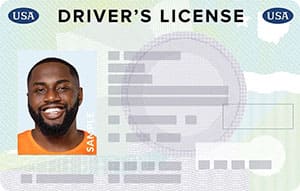- 0 Incorrect (3 allowed to pass)
- 0 Correct
- Updated for February 2025
- Based on official Pennsylvania Driver's manual
Free Pennsylvania DOT PA Permit Test Practice 2025
To get your Pennsylvania DOT Learner’s Permit, you must be at least 16 years old and pass a vision screening and written knowledge test. The knowledge test consists of 18 multiple-choice questions covering material outlined in the state’s Pennsylvania DOT 2025 Driver’s Manual. To pass, you must score at least 83% (15 out of 18 questions). If you fail, you must wait until the next business day to retest. Our practice tests are designed to help you pass the first time!
Our free online Pennsylvania DOT Permit Practice Test is updated for February 2025 and mimics real exam conditions based on the state manual with its questions and answers. To speed learning, immediate feedback is provided on all questions.
Pennsylvania’s Graduated Driver Licensing (GDL) program is designed to gradually introduce driving experience to minors. At age 16, you can apply for a learner’s permit, which allows driving under the supervision of a licensed driver who is 21 years or older. You must log at least 65 hours of supervised, behind-the-wheel practice (including ten at night and five in bad weather) over a six-month period. After six months, you can pass a road skills test for the next stage: the Junior License. This license has some restrictions. Only one non-family passenger under 18 is permitted, and unsupervised driving is only allowed between 5 AM and 11 PM (with exceptions for work or volunteer service or if accompanied by a family member who is 18 years or older). To get an unrestricted license, you must keep a clean driving record for one year, complete an approved driver’s education course, or turn 18.
If you’re 18 or older, most GDL requirements do not apply. You must still obtain a learner’s permit before you can get a driver’s license, although there’s no specific requirement for practice hours. Once you’re confident in your driving skills, you can schedule a road test and, if passed, obtain your unrestricted driver’s license.
Once you’re ready to apply for the permit, go to the DOT with proof of identity (birth certificate, passport), Social Security card, and proof of residence (utility bill, bank statement). If you’re under 18, you will need (signed in person) the Parent or Guardian Consent Form (Form DL-180TD). Submit the documents, pass a vision screening, pay the fee, and pass the official written test.
[faq]
FAQs
Can I take the permit test online?
No, in Pennsylvania, the permit test must be taken in person at a PennDOT Driver License Center. Online testing is not available.
How many questions are in the permit test?
The Pennsylvania permit test includes 18 questions. To pass, you must correctly answer at least 15 questions, which is an 83% passing score.
Do I need an appointment for the permit test?
Yes, an appointment is typically required for the permit test in Pennsylvania. It’s recommended to schedule it in advance through the PennDOT website or by calling a Driver License Center.
How should I prepare for my permit test?
Prepare for the Pennsylvania permit test by studying the Pennsylvania Driver’s Manual thoroughly. Practice tests can also help familiarize you with the format and types of questions on the actual test.
Do I need a permit if I’m over 18?
Yes, in Pennsylvania, even if you are over 18, you need to obtain a learner’s permit before you can take the road test for a driver’s license. The permit process involves passing the knowledge test and vision screening.
What is the cost of the permit test?
The fee for the learner’s permit test in Pennsylvania is $35. This fee includes the cost of the knowledge test, the permit, and your first driver’s license.
[/faq]
- Perfect for learner’s permit, driver’s license, and Senior Refresher Test
- Triple-checked for accuracy
What you need to know

What to expect on the actual PA DOT exam
questions
correct answers to pass
passing score
minimum age to apply
Helpful links
List of questions (classic view)
- You see a steady yellow “X” signal over your traffic lane. What does it mean?
- Large electronic flashing arrow panels may be used in work zones in both day and night to
- When you park next to a curb in Pennsylvania, your vehicle should be no more than ________ from the curb.
- What does this sign mean?
- When you approach a pedestrian who is carrying a white cane or walking with a guide dog, you must
- In Pennsylvania, a driver who is at least 21 years old may be charged with driving under the influence (DUI) if his or her blood alcohol concentration is ______ or higher.
- On a two-way, two-lane road, a single broken yellow centerline means that
- What does this sign mean?
- Under Pennsylvania law, which occupants of a vehicle must wear seat belts or suitable child restraints?
- Where there are both a solid and a broken yellow line between opposing lanes of traffic,
- In Pennsylvania, it is recommended that you maintain a following distance of at least ____ second(s) behind the vehicle ahead of you.
- What does this sign mean?
- Areas of the road that you cannot see in your mirrors are called
- When you come to an intersection, follow the _________ before you proceed.
- Under Pennsylvania law, you must use your headlights whenever you cannot see pedestrians or vehicles at least _________ ahead.
- This sign means that
- If an oncoming vehicle has its high beams on, you should look __________ until the vehicle has passed.
- If you must drive below 40 mph on a limited-access highway in Pennsylvania, use _________ to warn the drivers behind you.
- Which of the following statements about the right-of-way at intersections is FALSE?
- What does this sign mean?
More resources
- Alabama: Test 1 / Test 2
- Alaska: Test 1 / Test 2
- Arizona: Test 1 / Test 2
- Arkansas: Test 1 / Test 2
- California: Test 1 / Test 2
- Colorado: Test 1 / Test 2
- Connecticut: Test 1 / Test 2
- Delaware: Test 1 / Test 2
- District of Columbia: Test 1 / Test 2
- Florida: Test 1 / Test 2
- Georgia: Test 1 / Test 2
- Hawaii: Test 1 / Test 2
- Idaho: Test 1 / Test 2
- Illinois: Test 1 / Test 2
- Indiana: Test 1 / Test 2
- Iowa: Test 1 / Test 2
- Kansas: Test 1 / Test 2
- Kentucky: Test 1 / Test 2
- Louisiana: Test 1 / Test 2
- Maine: Test 1 / Test 2
- Maryland: Test 1 / Test 2
- Massachusetts: Test 1 / Test 2
- Michigan: Test 1 / Test 2
- Minnesota: Test 1 / Test 2
- Mississippi: Test 1 / Test 2
- Missouri: Test 1 / Test 2
- Montana: Test 1 / Test 2
- Nebraska: Test 1 / Test 2
- Nevada: Test 1 / Test 2
- New Hampshire: Test 1 / Test 2
- New Jersey: Test 1 / Test 2
- New Mexico: Test 1 / Test 2
- New York: Test 1 / Test 2
- North Carolina: Test 1 / Test 2
- North Dakota: Test 1 / Test 2
- Ohio: Test 1 / Test 2
- Oklahoma: Test 1 / Test 2
- Oregon: Test 1 / Test 2
- Pennsylvania: Test 1 / Test 2
- Rhode Island: Test 1 / Test 2
- South Carolina: Test 1 / Test 2
- South Dakota: Test 1 / Test 2
- Tennessee: Test 1 / Test 2
- Texas: Test 1 / Test 2
- Utah: Test 1 / Test 2
- Vermont: Test 1 / Test 2
- Virginia: Test 1 / Test 2
- Washington: Test 1 / Test 2
- West Virginia: Test 1 / Test 2
- Wisconsin: Test 1 / Test 2
- Wyoming: Test 1 / Test 2
Your go-to, trusted source
Experience the Driving-Tests differenceOur commitment to accuracy and quality in our practice tests
Explore our rigorous, multi-tiered verification process that ensures each question mirrors the official manual for unparalleled accuracy.

At Driving-Tests.org, we understand the importance of reliable and accurate practice tests to help you prepare for your DMV exam. That's why we've developed a meticulous process to create and continually update our practice questions, ensuring they reflect the most current driving laws and regulations.
Here's an inside look at how we maintain the highest quality in our practice tests.
Content Creation and Verification Process
- Alignment with Official Manuals:
Every question we develop is based on the most recent version of each state's official driving manual. Our team regularly monitors each state DMV's website for the latest updates to ensure our practice tests are always aligned with the most current information. - Community Feedback Integration:
We leverage feedback from our vast community of users to understand which topics are most frequently tested. This helps us focus on the areas that are most relevant and beneficial for your preparation. - Expert Content Creation:
Our in-house editor, Steven, who has extensive experience in driver education, crafts each question with precision. He conducts a thorough review of each question against the official manuals to ensure accuracy. - Rigorous Review Process:
Once Steven has finalized a set of questions, our team conducts a joint review session. This second level of scrutiny involves content accuracy, proofreading, and fact-checking to eliminate any errors. - User Feedback Mechanism:
After a question goes live on our site, we keep the lines of communication open. Each question features a feedback button, inviting users to report any issues or errors. This continuous feedback loop allows us to address and rectify any concerns promptly. - Responsive Updates:
In line with our commitment to accuracy, we quickly update our practice questions to reflect any changes in the DMV manuals. Additionally, we update the free electronic copy of the state's driver's license manuals on our site, typically within a few days after the DMV publishes them.
Our thorough quality control process ensures that you have access to practice tests that are as accurate and up-to-date as possible. We believe in the power of well-prepared drivers and are dedicated to providing you with the best study tools to help you succeed on your DMV exam.
Unlock Your Best Chance to Pass
Get instant access to 650+ exam-like questions tailored for PA.
See how Premium can help you pass faster, risk-free, with our 97% success rate.
Pennsylvania questions seen on the real test
Questions specific to your state. Breeze through your exam with the right tools.
97% of Premium users pass the first time
Compare with the average passing rate of just 49%.
Premium users succeed.Trusted by over 1.15 million customers
The only program recommended by DOTs nationwide.





